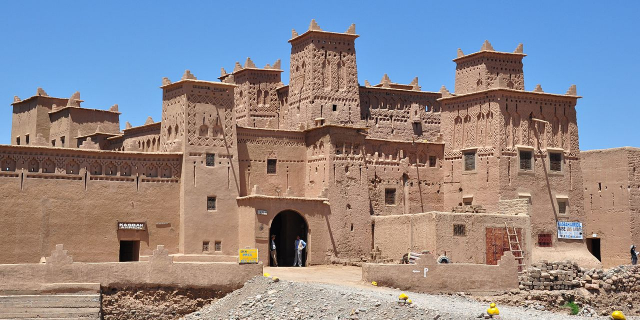النقوب
( N'Kob )N'Kob (Berber languages: ⵏⵏⵇⵇⵓⴱ [nnqqub], Arabic: نقوب, also spelled as Nkob) is a rural municipality in the Zagora province, in the Atlas Mountains. It is located near the Jbel Saghro and 24 kilometers from Tamsahelte. N'Kob is situated 35 kilometers west of the commune of Tazzarine and 40 kilometers from the intersection with the Draa Valley (Tansikht), the most spectacular stretch of the N9. The village has 45 Kasbahs and is surrounded by two oases full of palm trees, numerous of these ancient kasbahs have now been renovated and became hotels. The most widely spoken language in this region is Shilha (Tamazight). According to results of the 2014 general census of the population and households, the village has a population of about 7,209 people.
 The mountains of Saghrou in the High Atlas: the theater of colonial military operations.
The mountains of Saghrou in the High Atlas: the theater of colonial military operations.Every corner of the Ait Atta region continues to remember the Battle of Bougafer. Bougafer is named after a summit of peaks of Jbel Saghro which raises to an altitude of 2275 meters. The Ait Atta tribes marked Moroccan history since they were delivered a ruthless battle in Bougafer, equal connoisseur under the name the Battle of Saghro to the French troops allied with the forces of the Sultan during the protectorate, in 1933. They resisted for 42 days against 83,000 French soldiers supported by military aircraft. The Aitta warriors were led by Assou Oubasslam and they master their environment so much that they became almost invisible. The armies of the French occupation, led by General Henri, the commander-in-chief of the French forces in Morocco, suffered heavy and humiliating losses, despite their military superiority and sophisticated weapons, but they could not withstand the courage of the Ait Atta tribes, according to David Hart in The Aït ‘Atta of Southern Morocco, “the hardest single battle which the French had ever had to fight in the course of their ‘pacification’ of Morocco”.[1][2] After heavy losses on both sides, opponents agreed that the tribe could maintain its jurisdiction and not subject to the rule of Thami El Glaoui. An agreement was signed between the parties, which is in some of these clauses:
1 - Surrender to the Moroccan Makhzan. 2 - The removal of the authority of the Glaoui from the territory of Ait Atta. 3 - Keeping weapons in the hands of the inhabitants. 4 - Non-employment of the population in forced labor. 5 - Not forced inviting women to sing in official parties.[3][circular reference]






























Add new comment